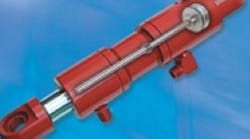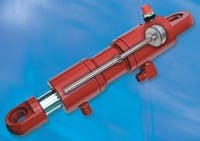One area that seems to plague electronics applications is in wiring connections. You can have the most sophisticated sensor and control system available, but if simple connections fail, so does the system. Heavy shock and vibration — in structures and in the fluid — are inherent to mobile equipment. Therefore, electrohydraulic systems in construction,mining, and other mobile equipment can be especially susceptible to faults from bad connections.
Designers at the Sensors Division of MTS Systems Corp., Cary, N.C., have been aware of this, which is why they have emphasized the importance of wire and cable connections and terminations. To answer the call for ever-increasing reliability of connections, they developed a more robust MH magnetostrictive sensor for mobile electrohydraulic applications. Combining proven magnetostrictive technology with a redesigned lid that provides a stronger wire and cable connection, the MH sensor is well suited for use in welded and tierod cylinders, or any cylinder where space is at a premium.
"Over the last three years, our experience has proven that the MH sensor is extremely reliable once installed inside the hydraulic cylinder, even when subjected to the harsh conditions found in off-highway machinery," said Drew Smedley, of MTS Sensors. "One need was a more robust wire and cable exit design, primarily to help prevent damage to seals during the installation process."
In response, MTS engineers developed a sealing system that is more tolerant of typical handling during installation. "Most importantly, we designed the mechanics to be completely compatible with the existing design for embedded, in-cylinder applications," Smedley said.
With a 100-G shock and 25-G vibration rating, the MH sensor was designed for rugged environments, especially those typically encountered in construction, agriculture, and other off-highway machinery.
The MH sensor consists of a redesigned sensor head with rugged housing and built-in electronics, a pressure-proof sensor pipe that protects the internal sensing element, and a position magnet. Along with high shock and vibration ratings, the sensor has 200V/m EMI protection.
Designed for cylinders with 2-in. or larger bores, the MH sensor strokes from 2 to 78 in. (50-2500 mm), doubling the available stroke length, while maintaining high levels of accuracy and repeatability.
The MH sensor provides four position output options: 0 to 5 V, 0 to 20 mA, 4 to 20 mA, or PWM (16 re-circulations).
M-Series sensors operate from –40 to 105°C and can be purchased with either individual wire or cable connection options that are compatible with typical mobile equipment electrical connector requirements. They meet ISO14982 standards for agricultural and forest machines and ISO7637-0/1/2 standards for road vehicles. The MH sensor can be installed from the cap or rod end of the cylinder, depending on the cylinder design.
For more information on mobile hydraulic position sensing, contact Drew Smedley at (919) 677-0100; [email protected]; or visit www.mtssensors.com


